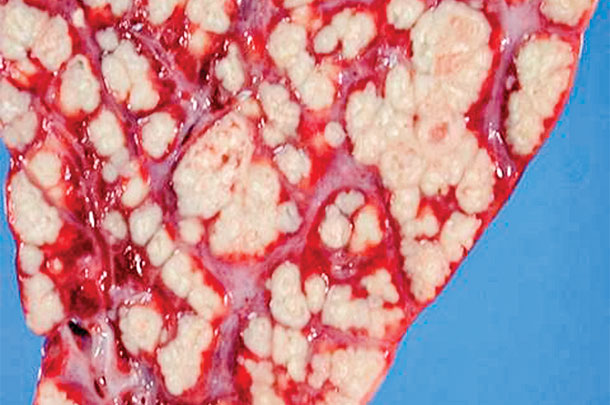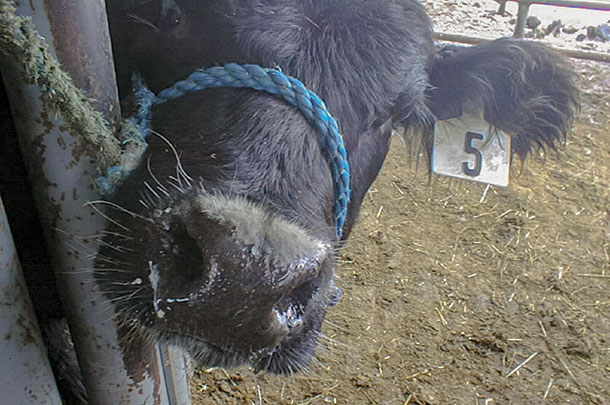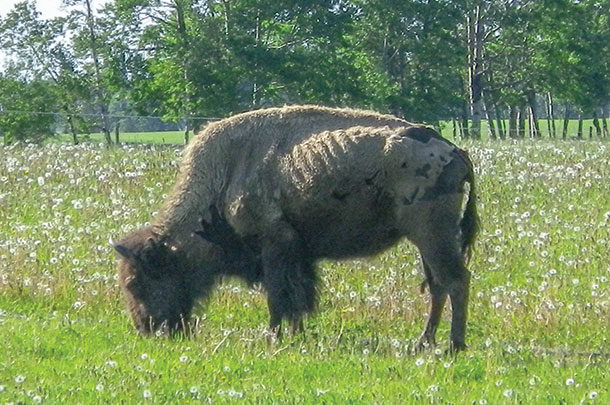Mycoplasma bovis is a devastating and often overlooked pathogen that affects cattle and bison. In cattle, it can cause mastitis in dairy cows, arthritis in cows and calves, pneumonia, and infections that may cause late-term abortion. Not all infected animals get sick; most of them shed the bacteria without signs.
Dr. Murray Jelinski, Western College of Veterinary Medicine – University of Saskatchewan, says there are many mycoplasmas that infect other animals and humans, but they tend to be specific to each host. The first cases of M. bovis in cattle in North America were reported in the early 1960s – associated with arthritis and mastitis.
“In the 1950s, people in Europe were talking about this organism, but no one knew what it was. In the 1980s, there were more reports of it in Canada and the U.S. and people knew it could cause mastitis in lactating cows and pneumonia in dairy calves,” says Jelinski.
Because of their structure, these bacteria don’t trigger much immune response, and it may take a while for signs of disease to appear. “This pathogen multiplies very slowly. The slower the organism grows, the less immune response in the body. It’s quiet and sneaky, like tuberculosis,” he says.
 Autopsy photo. Photo provided by Dr. Jerry Stokka.
Autopsy photo. Photo provided by Dr. Jerry Stokka.
“Mycoplasmas are the smallest self-replicating bacteria. They don’t have a well-defined cell wall or very many metabolic genes to keep them going. They are hard to culture because they grow so slowly, and it can be hard to find them in a tissue sample if you don’t know what to look for. When these organisms get into the lungs, they grow very slowly, and this has huge implications in the feedlot. When we look at diseased lungs in feedlot cattle, we see other pathogens, but now we’re also seeing more incidences of mycoplasma,” Jelinski says.
Dr. Chris Chase with the department of veterinary and biomedical sciences at South Dakota State University says this bacterium is not very well understood in terms of how it can evade the immune system and also be unresponsive to antibiotics.
“It took researchers 20 years to come up with the basic knowledge about the disease in pigs to develop a vaccine, with many people working on it, and we don’t have nearly as much research on Mycoplasma bovis in cattle,” he says.
Cattle mycoplasma
Mycoplasma has a serious effect on cattle, but is extremely deadly in bison. “We just don’t know enough about it, and there aren’t very many current studies, except in other parts of the world,” Chase says. “Researchers in Japan discovered that this bacterium can turn off its T-cell response and evade the immune system. It has other effects on the innate immune system as well.
“In beef calves, back in the 1990s, it was always a secondary invader, associated with some other disease or pathogen, and could be found in many animals. We started seeing it in baby calves in North Dakota – calves with a droopy ear and head tilt, like they had a head cold or ear infection. When we necropsied and cultured those, we got a pure culture of M. bovis.
“In recent years, it seems that M. bovis has become more virulent. It has gone from being a secondary problem [after initial infection with something else] to a primary problem in young calves.”
Dairy calves are susceptible, especially if they consume milk containing the pathogen, since M. bovis often causes mastitis in dairy cows. “If we see the head tilt in dairy calves, we’d just assume they ingested the pathogen from waste milk [from mastitis cows]. Seeing it in beef calves, however, told us that can’t be the case because beef cows rarely get mycoplasma mastitis.”
 A feedlot calf diagnosed with pneumonia from Mycoplasma bovis. Photo courtesy of Russ Daly, South Dakota State University.
A feedlot calf diagnosed with pneumonia from Mycoplasma bovis. Photo courtesy of Russ Daly, South Dakota State University.
These infections are difficult to treat; there are no really good antibiotics that work, or vaccines. “People resort to using autogenous vaccines. A commercial vaccine was marketed for a while with a conditional license, but none of the vaccines have been shown to be very efficacious; we don’t know what’s important to include in a vaccine. There are multiple strains of these bacteria, so some people put three to 10 different strains in a vaccine, hoping they might cover some that could be causing problems,” Chase says.
Supportive treatment over antibiotics
It’s a frustrating challenge because we don’t know the best antigen to include. Researchers figured out a way to grow the mycoplasma that causes disease in pigs and to get the right antigen and make it do what they need it to do for a vaccine, but no one has been able to do that yet with M. bovis.
“Also, we don’t have any antibiotics that do a good job, partly because it grows so slowly and doesn’t have a cell wall. We can’t use something like penicillin that affects the cell wall,” says Chase.
Many antibiotics are effective against fast-growing bacteria, and since M. bovis grows slowly, those antibiotics are ineffective. Supportive treatment is about the best we can do, and hope the animal can eventually fight it off.
These bacteria are often present in nasal passages of healthy cattle. “It’s already colonized in the upper nasal tract, and when these animals are stressed or if we give them a metaphylactic treatment when they arrive at a feedlot, this infection may get going,” Chase says. Antibiotics given as preventative treatment may knock out Mannheimia haemolytica in those animals, but it won’t affect M. bovis, so it proliferates.
“Broad-spectrum metaphylaxis drugs also kill some of the good bacteria that help keep M. bovis at bay,” Chase explains. Cattle coming into feedlots may get respiratory disease from stress within the first week (shipping fever), but lung infections from M. bovis tend to show up several weeks later, after this pathogen has gone on down into the lungs and is slowly growing.
The epidemic peak of shipping fever is eight to 12 days after arrival. “Mycoplasma cases are happening more like 30 or more days [after],” says Jelinski. “If we sample cattle upon arrival, we generally find Mycoplasma bovis in 5 to 10 percent of those calves’ nasal passages. These are healthy cattle coming off the trailer, and a small percent have mycoplasma. But if we sample all those cattle again in two or three weeks, we find it in almost all of them. It starts spreading in the pens of cattle,” he says.
“We have other pathogens causing pneumonia [pasteurella, mannheimia, etc.] and maybe mycoplasma is just one of the actors, waiting until other bacteria damage the lungs; then it gets in there and methodically grows. It’s almost like walking pneumonia in humans in that the cattle don’t appear clinically sick. But at postmortem, you wonder how the animal could have survived with so much lung damage,” says Jelinski.
“When we look at lungs from animals that died of BRD [bovine respiratory disease], we often see pathology associated with multiple pathogens. However, finding a caseonecrotic – cheeselike appearance – bronchopneumonia is a distinctive lesion associated with M. bovis. The lungs are filled with whitish nodules, which when cut with a knife have consistency of dried cottage cheese. There is no other organism that causes this appearance, so when you see that along with an infected joint, we call it CPPS [chronic pneumonia/polyarthritis syndrome] and can be pretty sure this is mycoplasma,” he says.
Catching it early
A small number of healthy animals are probably carriers and harbor the organism in nasal passages. “It then spreads during commingling in trucks and pens. If the animals remain healthy, Mycoplasma bovis is not an issue. But if they develop pneumonia, the organism uses this opportunity to infect the lung, where it grows slowly. If the animal dies early in the feeding period of a typical shipping fever, there may be very little evidence of M. bovis presence. But if the animal lives and develops chronic pneumonia, we see more of it at postmortem examination,” says Jelinski.
In beef cattle, M. bovis infections are more common in feedlot cattle than cow-calf herds. “M. bovis forms biofilms in the upper nasal passages – and these colonies are impervious to antibiotics – and microabscesses in the lungs,” says Chase. “When you cut into the lungs at necropsy, there are tiny abscesses all through the tissues,” he says. M. bovis infections do major damage to bison this way, and they quickly die.
Cattle don’t have strong lungs – not as much lung capacity as a horse, for instance. “Bovine lung capacity is borderline to begin with, and if the lungs get compromised by disease, as the animal grows it has less capacity, increasing the risk for problems. In summer heat, those cattle don’t have enough lung capacity to cool themselves and get in trouble quickly.” Heavy cattle in the feedlot are most at risk from reduced lung capacity.









